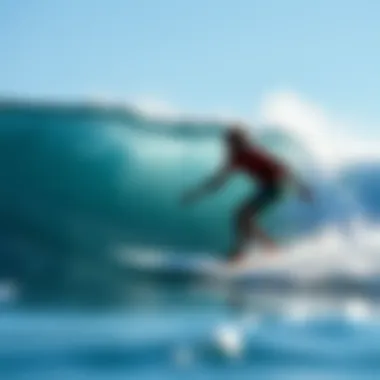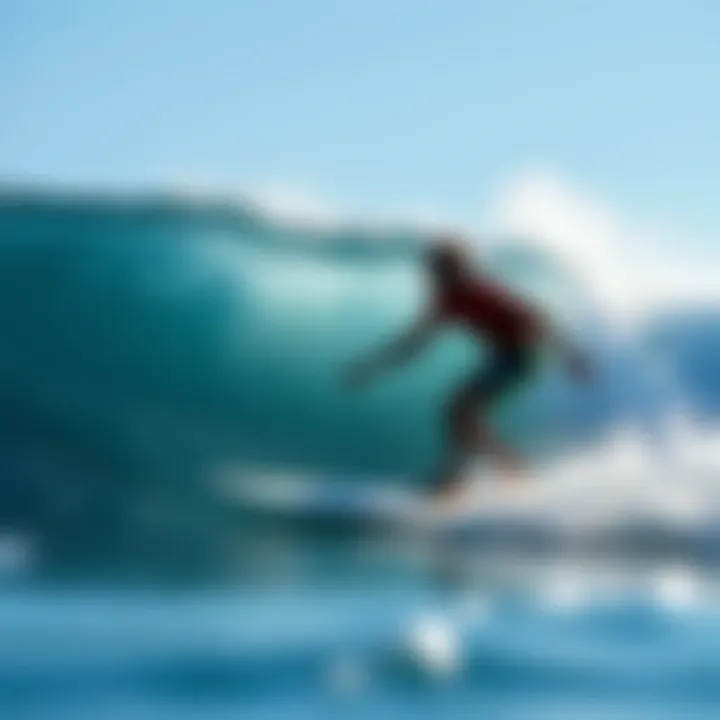In-Depth Look at Soft Top Brand Surfboards


Intro
Soft top brand surfboards have carved a special niche in the surfing world. Their soft foam tops, designed to provide safety and comfort, appeal not just to beginners but also to seasoned surfers looking for a more forgiving experience in the water. With their rise in popularity, understanding the benefits and nuances of these boards becomes essential for both new surfers and enthusiasts.
This comprehensive guide aims to peel back the layers on soft top surfboards, exploring their development, design intricacies, and impact on surfing culture. We will cover everything from the techniques to ride and adapt to these unique boards, to insights into the vibrant lifestyle surrounding them.
Surfing Techniques
Mastering the Basics
Getting started with soft top surfboards can be less intimidating compared to hard boards. These boards are more buoyant, allowing for easier paddling and quick catching of waves. The soft surface also reduces the risk of injury when you tumble into the water.
Key Basic Techniques:
- Paddling: Focus on laying flat on the board, using both arms to paddle, keeping your body center-balanced to maximize speed.
- Pop-Up: This is the transition from lying down to standing up. You’ll want to push up with both hands and slide your feet under you, balancing as you do so.
- Balancing: Once you’re up, keep your knees slightly bent and centered over the board.
Advanced Maneuvers
Once you’ve honed the fundamentals, you can look to dive into more advanced techniques which will undoubtedly elevate your soft top riding experience:
- Turning: For sharp turns, lean into your back foot and shift weight towards the side you want to turn. Soft tops are great for gradual turns but can require technique for sharper carves.
- Riding the Face: This is about positioning yourself correctly on the wave for maximum speed. Push off your back foot to move forward and keep an eye on the wave ahead.
"The nuances of soft tops equip surfers with a unique platform to explore maneuverability without the fear of harsh falls."
Surfing Lifestyle
Sustainable Surfing Practices
As surfing culture expands, so does the awareness of environmental impact. Many brands are stepping up, producing soft top surfboards using eco-friendly materials. This includes recycled foam and sustainable production methods that speak to the environmentally conscious surfer. Embracing green practices not only helps preserve our oceans but also encourages a responsible surf culture.
- Consider boards from brands utilizing eco-materials like biodegradable foam or responsibly sourced wood for fins.
- Participate in beach clean-ups and local conservation efforts to support marine ecosystems.
Surf Culture Around the World
Surf culture is a rich tapestry woven from diverse influences worldwide. From the beaches of Hawaii, known as the birthplace of surfing, to the coastal shores of Australia with its laid-back vibe, soft top surfboards find their place among all types of surf communities. Each region brings something unique to surf practices:
- Hawaii: A blend of tradition and modern techniques, where the history of surfing runs deep.
- Australia: Known for its innovativeness in surfboard design, Australian surfers often blend performance with quality crafting, even in the soft top category.
- California: An iconic surf hotspot that blends skater culture with surfing, often redefining trends in soft tops.
Through understanding and embracing these different cultures and practices, surfers can enrich their experiences and promote a sense of global camaraderie.
In the following sections, we will delve deeper into the intricate details of soft top surfboards, analyzing brands, their specific advantages, and considerations for maintenance.
Prelude to Soft Top Brand Surfboards
In recent years, the popularity of soft top surfboards has surged, making them a staple for both novice surfers and seasoned ocean-goers. This section aims to shed light on the significance of soft top surfboards, delving into various facets that contribute to their standing in the surf community. Not only do these boards offer a unique riding experience, but they also encompass an array of benefits that cater to different user demographics, from families sharing a day at the beach to individuals seeking to hone their skills.
Defining Soft Top Surfboards
Soft top surfboards can be characterized by their soft, foam tops which provide a cushioned feel when paddling or falling. Unlike traditional hard-top surfboards, these boards are designed with safety and ease of use in mind, making them forgiving for beginners, while still maintaining enough performance for more experienced surfers. Their design typically includes:
- A foam exterior that cushions falls—ideal for those just learning the ropes.
- Lightweight materials that allow for easier transportation.
- Wide and stable shapes that provide balance in the water.
For many, the soft top serves as a bridge to the world of surfing. It’s a practical choice that combines safety with enjoyment, encouraging more people to take up the sport.
Historical Context and Evolution
The evolution of soft top surfboards has roots stretching back to a desire for inclusivity in surfing. Initially, this design began gaining traction in the 1970s when an influx of beach culture made waves in popular media. It was during this time that manufacturers noticed a gap in products catering to beginners and families. Over the decades, advancements in materials and design have transformed the soft top surfboard, enhancing performance while retaining its approachable charm.
- 1970s: The era when soft tops emerged, primarily aimed at beginners.
- 1980s: Continued innovations led to stronger materials and broader shapes.
- 1990s onwards: The designs started to cater not only to novices but also to intermediate surfers, with brands emphasizing versatility and performance.
Through the years, soft top boards have adapted to trends while keeping their core focus intact: making surfing enjoyable and accessible. Today, they are not just for novice surfers but have found their place in various surf scenes. There’s a growing appreciation among enthusiasts who value the blend of safety, simplicity, and fun.
The significance of soft top surfboards lies in their ability to bring more people into the ocean and foster a love for surfing. This article will explore deeper elements, the design intricacies, market dynamics, and the evolving perspectives surrounding soft top surfboards.
Design and Construction Features


Design and construction features are pivotal when understanding soft top brand surfboards. These elements dictate not only the performance of the boards but also their usability, appeal, and resonance among various types of surfers. By examining the materials, design variations, and innovations, we can better appreciate what makes soft top surfboards a go-to choice for families, beginners, and even seasoned surfers.
Materials Used in Soft Top Surfboards
Materials are the backbone of soft top surfboards, and each type used plays a distinct role in how the board behaves in the water.
Core materials
The core of a soft top surfboard is chiefly made from materials like expanded polystyrene or polyurethane foam. This aspect is crucial because it significantly impacts the board's buoyancy and overall weight, making it easier for beginners to balance. The key characteristic of this foam is its lightweight nature, which is a significant advantage for younger surfers or those just starting. However, while these materials offer excellent floatation, they may not provide the same level of sturdiness as their hard top counterparts, leading to possible durability issues in challenging surf conditions.
Outer soft top layer
The outer layer of soft top surfboards typically consists of a soft, rubbery material, often referred to as EVA foam. This layer serves multiple purposes. First off, it provides a cushioned surface that enhances grip, giving riders a sense of security as they paddle and catch waves. The soft top is also designed to be gentle on the skin, reducing the likelihood of injuries during sessions. Another noteworthy feature is its water-resistant properties, which make maintenance a little easier. However, this layer may scuff and wear down faster compared to harder materials, especially if exposed to rough conditions too frequently.
Fin systems
Fin systems are a critical part of the surfboard design as they affect maneuverability and stability. Most soft top surfboards feature removable or fixed fins made from durable plastic, ensuring flexibility for the surfer. A notable trait of these fins is their capacity to adapt to various surfing styles and conditions. Choosing a fin system that's easy to manage can be beneficial for novices who may want to experiment with different configurations as their skills develop. The downside, however, comes into play when considerations about performance arise, as some surfers find that plastic fins lack the responsiveness that professional-grade materials can provide.
Design Variations and Innovations
When it comes to design, soft top surfboards have evolved in terms of shape, size, and integrated features, making them more appealing across a broad spectrum of surfers.
Shape and size options
Soft top surfboards are available in a myriad of shapes and sizes, ranging from longboards for cruising to shorter boards suited for more agile maneuvers. This variety allows surfers to select a board that aligns with their skill level and preferred surfing style. For instance, a wider board will lend itself well to beginners, offering extra stability in the water. Conversely, narrower shapes provide a more dynamic experience for experienced surfers looking for speed and agility. The unique feature here is the ability to cater to diverse user preferences. However, the vast selection can sometimes overwhelm buyers, leading to indecisiveness.
Integrated features
Many modern soft top surfboards now incorporate innovative features, such as built-in traction pads, comfortable handle grips, or even waterproof compartments. These additions enhance usability by increasing grip and making it easier to carry the board. A key highlight of integrated features is their ability to streamline the surfing experience without requiring additional accessories. However, one must take care not to prioritize novelty over practicality, as some of these features can add unnecessary weight or complexity to the board.
It's intriguing to see how the soft top surfboard design continues to flourish, keeping pace with the demands of surfers across the globe, while ensuring accessibility and enjoyment for newcomers.
Market Overview of Soft Top Brand Surfboards
The market for soft top brand surfboards holds a substantial place in the surfing community, appealing to a diverse range of surfers from beginners to experienced wave riders. This overview is vital, as it highlights the different dimensions of the market, including popular brands, emergent trends, and the unique characteristics that set soft top surfboards apart from their hard-top counterparts. Understanding the market dynamics can guide potential buyers in making informed decisions that cater to their individual surfing needs.
Popular Brands and Their Offerings
When delving into soft top surfboards, a few standout brands rise to the top, each offering unique features and appeals.
Brand A
Wavemaster has made a name for itself with its reliable construction and performance. Known for its blend of affordability and quality, Wavemaster surfboards are often chosen by families looking for a safe and enjoyable surfing experience. The key characteristic that sets Wavemaster apart is its lightweight design, allowing for ease of maneuverability in the water.
One notable feature is their soft-edged rails, which reduce the risk of injury, making them an excellent choice for beginners. However, while they excel in safety and ease of use, some advanced surfers might find them lacking in responsiveness compared to other brands. Overall, Wavemaster remains a solid choice for those just starting their surfing journey.
Brand B
Catching Waves stands out with its innovative approach to soft tops. This brand is known for infusing style with functionality. One prominent aspect of their surfboards is the use of eco-friendly materials, appealing to environmentally conscious surfers.
The unique design features, such as colorful, customizable graphics, allow users to express themselves on the waves. Despite being visually appealing, some performance-oriented surfers may question their durability under heavy use. Nonetheless, Catching Waves carves a niche that resonates with recreational enthusiasts, merging performance with personal identity.
Brand
SurfMate is another major player in the market, offering a blend of tradition and modern enhancement. SurfMate boards are popular for their stability and versatility, making them suitable for varying surf conditions. One commendable feature of SurfMate surfboards is their integrated buoyancy technology, which provides additional reliability while riding.
The price point makes SurfMate boards accessible without compromising on quality. Though some users have noted that their heavier weight can be a disadvantage during transport, the overall performance often outweighs this minor drawback. SurfMate caters to both novices and seasoned surfers seeking a dependable board.
Emerging Brands and Trends
The surfboard market is continually evolving, with emerging brands making waves and introducing fresh trends. These newer brands often focus on sustainability, incorporating recycled materials into their manufacturing processes. This shift towards eco-friendly practices reflects a broader industry movement that recognizes the significance of protecting ocean ecosystems. Emerging brands are not just competing on quality but also on their commitment to environmental stewardship, thus attracting a conscientious customer base.
Consumers are increasingly drawn to boards that provide unique experiences and customization options, catering to the diverse tastes and requirements of surfers today. As this sector continues to grow, keeping an eye on these trends can benefit anyone looking to enhance their surfing experience.
Understanding the market for soft top surfboards can significantly influence buying decisions and enhance the surfing experience.
Advantages of Soft Top Surfboards


Soft top surfboards have carved out a niche of their own within the surfing community. They present various benefits that cater to surfers of all skill levels, but particularly for beginners and families looking for a more approachable experience. This section delves into the advantages that soft top surfboards bring, examining safety features, user-friendliness, and their versatility in diverse surf conditions.
Safety Benefits
One of the primary draws of soft top surfboards is their inherent safety features. Unlike their hard top counterparts, these boards are equipped with a softer, cushioned surface, which significantly reduces the risk of injury during mishaps in the water. Surfing, while exhilarating, can be risky, and a board made from softer materials acts as a buffer against collisions.
Moreover, the lightweight design of soft tops means that they are easier to handle, especially for new surfers who might not yet be adept at managing their boards in rough waters. If a surfer were to fall and hit the board, the softer surface lessens the impact, making it a safer choice for all, especially kids.
"Safety doesn’t have to come at the cost of fun. Soft top surfboards make learning to surf less daunting and more enjoyable." - Expert Surf Coach
User-Friendly Attributes for Beginners
For those stepping onto a surfboard for the first time, soft tops are often the go-to choice. They offer several user-friendly attributes that can diminish the steep learning curve typically associated with surfing:
- Stable Platform: The wider and thicker design of many soft top boards provides greater stability. This allows beginners to feel more secure while they practice paddling and catching waves.
- Easy to Handle: The lighter construction allows users to maneuver and carry their boards with minimal effort. New surfers can easily manage them, which makes the entire experience feel much less intimidating.
- Catching Waves: The buoyancy of soft tops also plays a key role. Their high volume enables beginner surfers to paddle into waves more efficiently, increasing the chances of standing up and enjoying that satisfying ride.
These features not only foster confidence but also cultivate a more enjoyable introduction to surfing.
Versatility in Various Surf Conditions
Soft top surfboards are remarkably versatile in terms of functioning across a range of surf environments. Whether it be small, gentle waves or more robust conditions, these boards can adapt:
- Small and Gentle Waves: Ideal for beginners, soft tops perform exceptionally well in mellow surf, allowing surfers to practice their skills without the added pressure of formidable wave conditions.
- Choppy Waters: The stability offered by soft tops makes them effective in choppy conditions, where a hard board might become unmanageable. Surfing on a soft top can still be enjoyable and safe, even when the tide is a bit unpredictable.
- Family-Friendly Surfing: As more families are hitting the waves together, the versatility of soft tops caters beautifully to mixed-age groups. Parents can join their children in trying out surfing, regardless of the skill disparities that might exist.
In summary, soft top surfboards represent a significant advancement in making surfing more accessible. Safety, ease of use, and adaptability to varying conditions make them a popular choice for novices and families alike. Their design caters to fun and safe play in the water, granting a memorable experience for both new surfers and seasoned enthusiasts.
User Demographics and Preferences
Understanding the user demographics and preferences when it comes to soft top brand surfboards is crucial for both manufacturers and surfers alike. It provides insights into who is riding these boards and why. With the surfboard market becoming increasingly diversified, recognizing different user needs means brands can better cater to specific groups, ultimately enriching the surfing experience.
In this section, we’ll delve into the characteristics of families and recreational surfers, as well as those of intermediate to advanced surfers, highlighting their distinct preferences and requirements.
Families and Recreational Surfers
Families and recreational surfers tend to gravitate toward soft top surfboards due to their safety and user-friendliness. These groups generally prefer a more laid-back surfing experience, often riding in gentle waves rather than executing tricks or navigating heavy swells. The primary considerations for this demographic include:
- Safety: Soft top boards have a cushioned surface, making them less likely to cause injury during falls or collisions. This is particularly advantageous for families with children.
- Ease of Use: Soft tops tend to be more stable, which aids balance for beginners or those who haven’t taken to surfing with the same fervor as seasoned riders. Newcomers appreciate how forgiving these boards can be on their learning curve.
- Versatile Designs: Many families look for boards that can accommodate various body types and skills. Soft tops often come in a range of sizes, from longboards to fun shapes, making them accessible to everyone—a major plus for family outings.
Overall, recreational surfers are looking for a fun, stress-free experience in the water, and soft top boards make that easy for the whole family.
Intermediate to Advanced Surfers
While soft top surfboards are commonly associated with beginners, intermediate and advanced surfers are finding their place in this category, too—often riding them for different reasons. Here’s what makes them a fit for these more experienced surfers:
- Varied Wave Conditions: Surfers at this level appreciate soft tops for their versatility across different surf conditions, from small beach breaks to bigger swells. Great for casual sessions when performance is less of a priority.
- Fun Factor: The engaging surf experience on a soft top can invoke a sense of nostalgia or whimsy, encouraging seasoned surfers to enjoy the sport in a different light, free from the pressures of performance.
- Durability and Maintenance: To the intermediate and advanced crew, soft tops are robust enough for everyday use and require less maintenance than hard tops, which means more time in the water and less time fussing over gear.
Maintenance and Care
Maintaining a surfboard, particularly one with a soft top, is crucial for performance longevity and user safety. Neglecting proper maintenance can lead to unwanted wear and tear, ultimately affecting the board's performance in the water. A well-cared-for surfboard provides better buoyancy, stability, and safety for the rider. Several specific elements deserve attention in cleaning and storing soft top surfboards to ensure they remain in prime condition and ready for action.
Cleaning Practices
When it comes to cleaning your soft top surfboard, proper techniques go a long way. Regular cleaning helps remove sand, salt, and grime that can accumulate over time. Here are some steps to follow:
- Rinse with Fresh Water: After every surf session, give the board a swift rinse with fresh water. This simple action helps wash away salt and sand that can be abrasive to the surface.
- Use a Gentle Cleaner: If heavier dirt persists, a mild, biodegradable soap mixed with warm water does wonders. Avoid harsh chemicals which can damage both the soft top and the environment.
- Soft Cloth or Sponge: Employ a soft cloth or sponge to gently clean the surface. Scrubbing too hard can lead to scratches or wear on the soft layer.
- Dry Thoroughly: After rinsing, dry the board with a soft towel to prevent spots and watermarks. This not only enhances appearance but also helps prevent mold or mildew.
By implementing these cleaning practices, surfers can extend their board’s lifespan and maintain optimal performance in the ocean.
"A clean board not only looks good but also feels good on the waves!"
Storage Recommendations
Proper storage is another key aspect of surfboard maintenance. How, where, and when you store your soft top surfboard can make a significant difference in its condition over time. Here are some solid tips:
- Avoid Direct Sunlight: Extended exposure to UV rays can fade colors and weaken the materials over time. Instead, store the board in a shaded area or inside.
- Horizontal Storage: If possible, lay your board flat or use a board bag for storage. Hanging it can create warps or bends, while leaning may lead to unintentional dings.
- Temperature Considerations: Try to keep your surfboard in a moderate temperature space. Extremes of heat and cold can cause the materials to expand and contract, negatively impacting the integrity of the board.
- Keep Away from Heavy Objects: Don’t stack stuff on top of your board. Weight can lead to pressure dents or cracks, particularly in the foam core of soft tops.


Implementing these storage recommendations not only enhances the board’s lifespan but also keeps it ready for your next surf escapade. Neglect in both cleaning and storage can spell disaster; treating a soft top surfboard with care leads to countless joyful rides on the waves.
Environmental Considerations
Environmental factors play a pivotal role in the surfboard industry, especially as more consumers and brands become aware of their ecological footprint. Soft top surfboards, in particular, have begun to attract attention not only for their user-friendly nature but also for their environmental implications. This section discusses sustainability in surfboard manufacturing and how soft top boards affect surfing culture, emphasizing the intersection between recreation and ecological responsibility.
Sustainability in Surfboard Manufacturing
When we talk about sustainability in surfboard manufacturing, it encompasses the materials used, the production processes, and the overall environmental impact. The traditional surfboard, often made with polyurethane foam and fiberglass, poses significant environmental challenges. Many surfers are switching to soft tops, which are sometimes crafted with more eco-friendly materials.
Key aspects of sustainability in soft top surfboards include:
- Bio-based materials: Some brands are exploring the use of bio-resins and recycled materials to create surfboards that are less harmful to the environment. This innovation showcases the possibility of reducing dependency on petroleum-based products.
- Production processes: Utilizing energy-efficient methods and reducing waste throughout the manufacturing process can minimize the carbon footprint associated with surfboard production. Brands that implement these practices can significantly lessen their environmental impact.
- Lifecycle considerations: Soft top surfboards are often designed for longevity, meaning they are less likely to end up in landfills. Their durability can prompt a circular economy, allowing boards to be refurbished or recycled instead of discarded.
Emphasizing sustainable practices in surfboard manufacturing not only appeals to environmentally conscious consumers but also sets a standard within the industry. By prioritizing eco-friendly methods, brands can cultivate a loyal following among surfers who value both performance and environmental stewardship.
Impact of Soft Top Boards on Surfing Culture
The influence of soft top boards extends beyond practical aspects of usability; they play a significant role in molding the surfing culture itself. As more surfers take up the pastime, the entry point provided by soft tops has democratized the sport. No longer do surfers need to be experts to catch a wave—these boards have facilitated a more inclusive surfing community.
Some notable points regarding their cultural impact include:
- Community engagement: Soft top surfboards have fostered a welcoming atmosphere in local surf spots. Families, beginners, and those who may have felt intimidated by the sport now find a place to engage with others who share similar interests. As a result, surf schools and community events centered around soft tops are on the rise.
- Shifting perceptions: Once viewed as a mere beginner’s board, today’s soft tops are taking center stage, embraced by seasoned surfers as well. This shift shows a cultural evolution that celebrates versatility, allowing individuals to enjoy surfing without the pressure of performance.
- Environmental advocacy: With an increase in awareness regarding sustainability, many surfers using soft top boards have started to advocate for ocean conservation. This demographic is often more attuned to environmental issues, resulting in a culture that places importance on preserving the waters they ride.
"Surfing is a way of life that aligns perfectly with environmental advocates, as each wave reminds us of nature's power and need for protection."
By acknowledging the importance of environmental considerations in the realm of soft top brand surfboards, we celebrate both the sport itself and our responsibility towards Mother Earth.
Comparative Analysis: Soft Top vs. Hard Top Surfboards
The discussion around soft top and hard top surfboards is crucial for surfers of all skill levels, as it shapes their riding experience, comfort, and safety in the water. Picking the right type of surfboard entails understanding the strengths and weaknesses that come with each variant. While soft tops have gained popularity for their safety and ease of use, hard tops maintain a reputation for performance and style. This section will delve into various aspects that define these two surfboard categories and provide clarity for those making a choice.
Performance Metrics
When it comes to performance, the difference between soft top and hard top surfboards can be quite pronounced. Soft tops often cater to beginners, mainy due to their forgiving nature. The outer soft layer provides a cushioned feel, making them easier to balance on and minimize injuries during falls. However, this does not mean that they lack performance.
- Stability: Soft top boards tend to be more stable, which is a significant advantage for newbies finding their footing.
- Speed: Hard top surfboards, on the other hand, can provide better speed and maneuverability. This is crucial for more experienced surfers who crave dynamic turns and quick responses.
- Wave Handling: In heavier surf, hard tops often excel due to their rigid design, allowing for sharper turns and more control when navigating through challenging conditions.
In brief, while soft tops are well-suited to those starting out or looking for a more laid-back ride, hard tops offer the performance edge that seasoned surfers frequently demand.
Cost Analysis
In terms of pricing, there is a noticeable gap between soft top and hard top surfboards. Generally, soft tops are more budget-friendly, making them appealing for families and beginners who may not want to invest a hefty sum into surfing right away.
- Price Range: Soft top boards can range anywhere from $200 to $500, depending on the brand and size. This accessibility is vital, especially for those just dipping their toes into surfing.
- Investment in Hard Tops: Conversely, hard tops, due to their construction and performance capabilities, usually range from $600 to $1200 or more. This cost reflects the advanced materials and technology that go into crafting them, resulting in a product intended for durability and high performance.
- Long-term Value: While hard tops require a more substantial initial investment, they often last longer with proper care. This makes them a valuable choice for dedicated surfers who eventually want to upgrade once they build skills and confidence.
A clear understanding of these costs helps inform decisions, aligning a surfer’s budget with their aspirations and the amount of time they plan to spend riding the waves.
In summary, whether one chooses a soft top for its forgiving nature or a hard top for high-performance requirements, each board type has its unique offerings, accommodating a range of personal preferences and surfing styles.
For more details on surfboard economics, you might check Wikipedia or related discussions on Reddit.
Ultimately, the choice between soft top and hard top surfboards is equally about personal preference and how the product fits into one's surfing journey.
Ending and Future Trends
In crafting a solid understanding of soft top brand surfboards, it becomes clear that the significance of this topic transcends mere recreational use. Soft top surfboards have evolved considerably, shaping the landscape of the surfing community. This section will tie together all the salient points from previous sections, reinforcing the benefits and implications surrounding soft top surfboards while introducing a glimpse into the likely future developments in this niche.
Summary of Key Insights
Soft top surfboards serve multiple purposes, not only catering to novices seeking ease of use but also attracting seasoned surfers looking for safety and versatility. Their construction predominantly features soft materials that mitigate injury risks, making them suitable for families, children, and those eager to embrace the sport without fear.
Key insights can be summarized as follows:
- Safety and User-Friendliness: Soft tops reduce the risk of injury during falls, which is especially beneficial for beginners.
- Market Diversity: A spectrum of brands, from established names like Wavestorm to emerging players, ensure ample choices for consumers.
- Environmental Impact: The shift towards sustainable materials highlights an increasing responsibility of brands toward ecological concerns in surfboard manufacturing.
- Comparative Benefits: While soft tops are often perceived as beginner boards, they excel in various conditions and can serve advanced surfers as well.
Predictions for the Soft Top Surfboard Market
The trajectory of the soft top surfboard market appears promising, influenced by both consumer demand and shifting environmental priorities. As more individuals embrace surfing, new trends can emerge as follows:
- Increased Variety: Anticipate ongoing design innovations that cater to specific surf conditions, such as shorter boards for performance and longer boards for stability.
- Sustainability Focus: Expect manufacturers to incorporate biodegradable materials and eco-friendly production methods, reflecting broader consumer trends toward sustainability.
- Enhanced Technological Features: As technology advances, features like built-in fins, stability aids, or modular elements may become commonplace in soft top designs.
- Cultural Impacts: The rising popularity of soft top boards could birth new surfing communities and cultures, pushing for a more inclusive approach to the sport.
"The evolution of soft top surfboards marks a significant stride towards making surfing more accessible, safe, and environmentally conscious, ultimately reflecting a positive shift in the sport's culture."















